Ágnes Ivacs, János Sugár (eds.): Buldózer: Médiaelméleti antológia (1997) [Hungarian]
Filed under book | Tags: · control society, critique, internet, media culture, media theory, tactical media

An anthology of contemporary media theory in Hungarian, derived from the Metaforum conference series and Nettime mailing list.
Contents:
Introduction by Janos Sugar (English)
Preface by Geert Lovink (English)
I.
Gilles Deleuze: Postscript on the Societies of Control
Thomas Pynchon: Is it O.K. to be a Luddite?
Tjebbe van Tijen: Ars Oblivivendi
Bruce Sterling: The Brief History of the Internet
II.
Richard Barbrook, Andy Cameron: Californian Ideology
Manuel De Landa: Markets and Antimarkets
closing debate of MetaForum 3
Felix Stalder: Financial Networks
Matthew Fuller: Spew- Excess and Moderation on the Networks
Critical Art Ensemble: Net Realities – Utopian Promises
Data Trash an interview with Arthur Kroker by Geert Lovink
János Sugár: Paradigm Shift Interruptus
III.
Pit Schultz: The Final Content
Geert Lovink: A Push Media Critique
Alexei Shulgin: Art, Power, and Communication
Calin Dan: Journey through a Data Room
David Garcia, Geert Lovink: ABC of Tactical Media
Miklós Peternák: In Medias Res – The Man without Interface
Lev Manovich: Digital Reality
Hans-Christian Dany: Schizos Still Wanna Have Fun
Michael Heim: Anxieties
IV.
Attila Kotányi: Is There Any Media Criticism That Isn’t Suicidal?
Gábor Bora: AI Service
Alpár Losoncz: Digitalization of Borders
Erik Davis: Technoculture and the Religious Imagination
Peter Lamborn Wilson (Hakim Bey): Net-Religion – War in Heaven
Edited by Agnes Ivacs and János Sugár, in cooperation with Diana McCarty, Geert Lovink, and Pit Schultz
Biographical notes by Diana McCarty
Publisher Media Research Foundation, Budapest, October 1997
Layout: Balazs Boethy using Heath Bunting’s graphics
ISSN 1417-6033
220 pages
PDF, PDF (1 MB)
HTML
multiple formats
Critical Art Ensemble (1994-2006)
Filed under book | Tags: · activism, art, biotechnology, control society, copyright, cultural resistance, tactical media, transgenics, virtuality
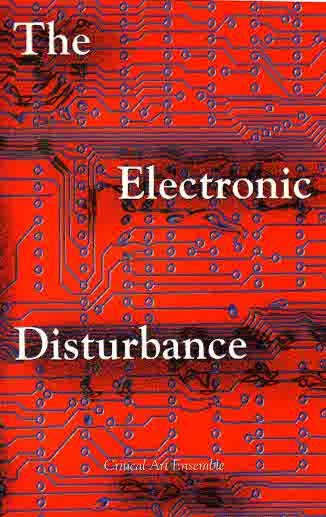
The Electronic Disturbance (1994)
The Critical Arts Ensemble is a virtual collective. This collection of essays and short pieces examines the changing rules of cultural and political resistance: “The current technological revolution has created a new geography of power relations — as data, human beings confront an authoritarial impulse that thrives on absence. As a virtual geography of cognizance and action, resistance must assert itself in electronic space.”
Publisher Autonomedia, May 1994
ISBN 1570270066

Electronic Civil Disobedience and Other Unpopular Ideas (1997)
In the age of global, nomadic capital, the CAE attempts to lay the foundation for the growth of nomadic resistance. Utilizing the tools of its enemy, the CAE suggests that a new cultural and political resistance is possible. Fusing a situationist-influenced concept of contestational art, an understanding of the parallel nature of cultural and political action borrowed from Gramsci, and a hacker’s deep understanding of how new technology functions, ECD is a launch point for debating the nature of power and resistance in the information age.
Publisher Autonomedia, May 1997
ISBN 9781570270567
commentary (Stefan Wray)
authors
publisher
PDF
View online, cont. (La Résistance électronique et autres idées impopulaires, French)
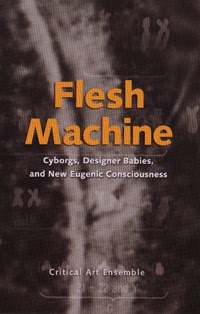
Flesh Machine: Cyborgs, Designer Babies, and New Eugenic Consciousness (1998)
Having elsewhere explored the dimensions of social and political control in electronic culture, the Critical Arts Ensemble here turns full frontal towards the body, arguing that utopian promises of virtuality are simple distractions from the real project: the deployment of biotechnologies upon the bodies of citizens in the service of the transnational order.
Publisher Autonomedia, March 1998
ISBN 9781570270673
PDF
PDF (Η μηχανή της σάρκας: Εκδόσεις των ξένων, Greek)
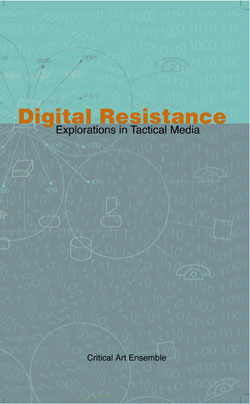
Digital Resistance: Explorations in Tactical Media (2000)
Essays in cultural politics and technology from the collective authors of Electronic Disturbance, Electronic Civil Disobedience and Flesh Machine. Chapters in this new volume include “Electronic Civil Disobedience and the Public Sphere,” “The Mythology of Terrorism on the Net,” “The Promissory Rhetoric of Biotechnology,” “Observations on Collective Cultural Action,” “Recombinant Theater and Digital Resistance,” “Contestational Robotics,” “Children as Tactical Media Participants,” and “The Financial Advantages of Anti-Copyright.”
Publisher Autonomedia, April 2000
ISBN 1570271194
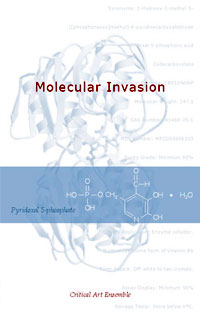
The Molecular Invasion (2002)
Having exhausted the possibilities for geographic colonial expansion, as well as reaching the fiscal limitations of virtual space, capital begins its invasion of a new frontier — organic molecular space. The Critical Art Ensemble began mapping this development in Flesh Machine (Autonomedia, 1998) by examining the use of reproductive technologies and their promise for achieving an intensified degree of control over worker and citizen. The Molecular Invasion acts as a companion to this first book by mapping the politics of transgenics, and offering a model for the creation of a contestational biology, as well as providing direct interventionist tactics for the disruption of this new assault on the organic realm.
Publisher Autonomedia, April 2002
ISBN 1570271380, 9781570271380
140 pages
PDF
PDF (Molekularna invazija, Croatian)
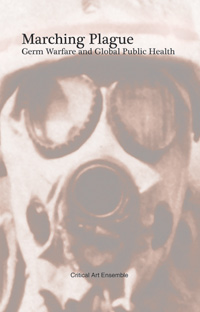
Marching Plague: Germ Warfare and Global Public Health (2006)
The sixth Critical Art Ensemble book offers a radical reframing of the rhetoric surrounding germ warfare. After refuting the idea that massive biological attack is a probable future occurrence, the book goes on to argue that biological weapons programs primarily serve the economic interests of the military-security complex, squandering resources needed to fight the massive loss of life each year from emerging infectious diseases. The book also includes two appendices examining the case of the U.S. Justice Department against Steve Kurtz, for which the original manuscript of the book was seized in the state’s investigation.
Publisher Autonomedia, 2006
ISBN 157027178X, 9781570271786
148 pages
review (Randall Packer)
authors
publisher
Next 5 Minutes 4 Reader (2003)
Filed under book, catalogue | Tags: · activism, tactical media

“Next 5 Minutes is a festival that brings together media, art and politics.
Next 5 Minutes revolves around the notion of tactical media, the fusion of art, politics and media. The festival is organised irregularly, when the urgency is felt to bring a new edition of the festival together.
The fourth edition of the Next 5 Minutes festival (September 11-14, 2003) was the result of a collaborative effort of a variety of organisations, initiatives and individuals dispersed world-wide. The program and content of the festival is prepared through a series of Tactical Media Labs (TMLs) organised locally in different cities around the globe. This series of Tactical Media Labs started on September 11, 2002 in Amsterdam and they continued internationally right up to the festival in September. TMLs have been organised in: Amsterdam, Sydney, Cluj, Barcelona, Delhi, New York, Singapore, Birmingham, Nova Scotia, Berlin, Chicago, Portsmouth, Sao Paulo, Moscow, Dubrovnik, and Zanzibar.
The program of Next 5 Minutes 4 was structured along four core thematic threads, bringing together a host of projects and debates. These four thematic threads were:
‘The Reappearing of the Public’ deals with the elusiveness of the public that tactical media necessarily needs to interface with, and considers new strategies for engaging with or redefining ‘the public’.
‘Deep Local (Growing Roots for the Global Village)’, which explores the ambiguities of connecting essentially translocal media cultures with local contexts.
‘The Tactics of Appropriation’ questions who is appropriating whom? Corporate, state, or terrorist actors all seem to have become effective media tacticians, is the battle for the screen therefore lost?
‘The Tactical and the Technical’ finally questions the deeply political nature of (media-)technology, and the role that the development of new media tools plays in defining, enabling and constraining its tactical use.”
Edited by Thomas Comiotto, Eric Kluitenberg, David Garcia, and Menno Grootveld
Published in Amsterdam, 2003
140 pages
Event documentation (TacticalMediaFiles.net)
PDF (updated on 2019-5-30)
Comment (0)
